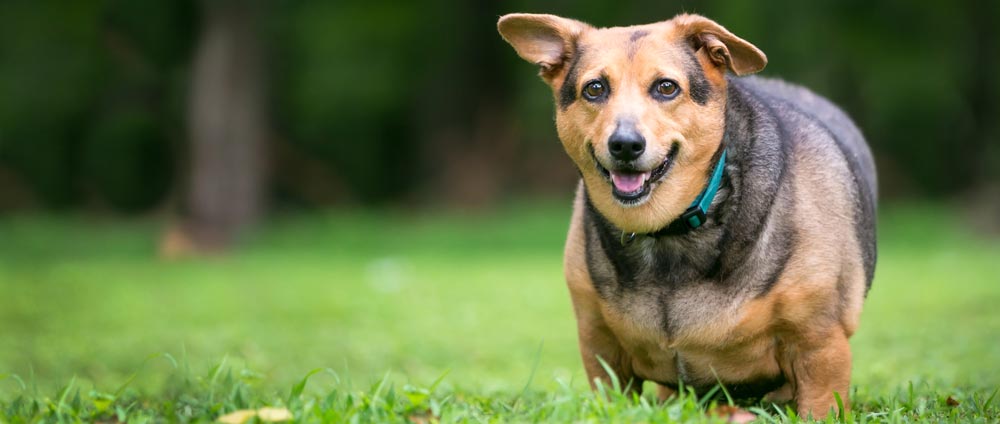Is my dog fat, skinny or the perfect weight?
November 01, 2021 | By Vedrana Nikolic

As responsible dog owners, it's our duty to keep our dogs in the best health we possibly can. That means making sure they are a perfect weight. Of course, there are fluctuations in body weight just as there are in humans. But dogs have healthy weight ranges that we should always keep in mind as we care for our dogs.
How can we determine if our dogs are at the ideal weight anyway? Is there a way of eyeballing it if you can't constantly measure them? You can and we'll show you how!
Why Does Your Dog's Weight Matter?
To keep your dog happy and healthy, bodyweight is a huge factor. More so than you probably think.
Sure. We've all seen those low energy dogs like the fat, jolly, neighbourhood Labrador with a round face and a waddling walk. That dog may be happy and the owner may be certain that they love their food, but their internal organs tell a different story.
Your dog doesn't have the same awareness of how much they are eating as we do. It's not entirely true that a dog will eat until they die. They do have a concept of being full. However, for the most part, dogs do better with regimented meal times as opposed to nibbling throughout the day like cats. It depends on your dog's specific eating habits though. Adapt as necessary.
What Happens If My Dog Is Obese?
Obesity in dogs is an epidemic in itself. It's estimated that 25-30% of dogs in North America are clinically obese. Obesity in dogs is also much more common than underweight issues. Particularly for dogs who are truly loved by their owners. It's rare for an owner to starve their dog accidentally. But overfeeding is a slippery slope. It starts with giving your dog spare scraps from your own food. Then you introduce more treats to make your dog feel even more loved. It all adds up, this is why it's critical to feed your dog the correct amount based off their size and activity levels.
Obesity in dogs can cause:
- Hypertension
- Diabetes
- Bladder stones
- Osteoarthritis
- Heart disease
- Increased risk of cancer
What Happens If My Dog Is Underweight?
Again, this is relatively rare in dogs with owners. Undernourishment is more commonly seen in stray dogs or abused dogs. Even if you are a new owner and are underfeeding your dog, your dog will likely be begging for food or stealing scraps from bins, etc, which gives a clear signal that they are hungry.
Underweight issues present themselves in dogs with health problems too. Losing weight could be a sign that your dog has a hidden ailment such as kidney or liver failure.
If your dog is underweight, they may suffer from:
- Weakened immune system
- Loss of muscle strength
- Excessive shivering from being cold
- Skin conditions
- Weakened bones
- Hormone disorders
- Reduced mobility
How Can You Tell If Your Dog Is Underweight or Overweight?
Your veterinarian will have a scale by which they measure your dog's weight. It'll be specific to your dog's breed, age and sex. You can often find these guidelines online if you have the means to measure your dog quite often.
But there is another way.
Pets have a version of BMI called BCS or Body Condition Scores. By these measures, you can determine whether your dog is in a healthy weight range, just by looking at them and feeling their body.
There are two scales. 1-5 and 1-9. Most vets prefer the 1-9 scale so we'll use that one today.
9-point Body Condition Scores
1/9 Emaciated
You can tell if your dog is emaciated if their ribs, backbone and pelvic bones are very visible. They poke out from the skin clearly. The skin seems thin and delicate. You can see a loss of muscle mass. The waistline is very defined with a severe tummy tuck.
2/9 Very Thin
The waistline is still very defined with a severe tummy tuck. However, there is less muscle mass loss as the previous category. Ribs, backbone and pelvic bones are visible but don't stick out as much.
3/9 Thin
If your dog is thin, their ribs, backbone and pelvic bones will be easy to feel and somewhat easy to see. They'll also have a severe tummy tuck and the waistline will be very defined.
4/9 Underweight
Your dog is underweight if you can easily feel their ribs, backbone and pelvic bones. However, you can't see these bones from the surface of their skin. The waistline is obvious but not quite as severe as the previous categories. There is also an obvious tummy tuck.
5/9 Ideal weight
Your dog is at an ideal weight if you can feel their ribs, backbone and pelvic bones under a thin layer of fat. Waistline and tummy tuck are easy to see but not severe.
6/9 Overweight
If your dog is overweight, there will be a thicker layer of fat over the ribs, backbone and pelvic bones. You can still feel them but the layer of fat makes it harder. The tummy tuck is more slight. The waistline is also more gradual and curved.
7/9 Heavy
The ribs are covered in a heavy layer of fat so it's much harder to feel them. You'll likely need to apply a fair bit of pressure to feel the ribs, backbone and pelvic bones. You can't see them at all. You can't see a waistline at all. You can still see a tummy tuck but it's not at all obvious.
8/9 Obese
Your dog is considered obese if you have to apply extreme pressure to feel their ribs, backbones and pelvic bones. They are enveloped in a thick layer of fat. There is no tummy tuck and no waistline at all. This gives them a sausage-like shape.
9/9 Severely Obese
Your dog is considered severely obese if you cannot feel their ribs, backbone or pelvic bones at all - even with extreme pressure. The layer of fat is too thick. Their waistline protrudes outward giving them a round appearance. The tummy rounds downward so there is no tummy tuck.
Looking After Your Dog's Weight
So now you can identify where your dog may be on the weight scale, you can better care for their health overall. If they are overweight, take a look at the AADF guide to achieving healthy weight loss. If your dog is chronically underweight, it might be a sign of an underlying health problem so it's usually best to consult a vet before embarking on any weight gain programmes.
We hope this article was helpful in keeping your dog at a healthy weight!
About the author
 Vedrana Nikolic from Gentle Dog Trainers in Australia is a writer, anthropologist and dog lover. She is currently pursuing a master's degree in semiotics and is passionate about the study of human and animal language and communication. Vedrana Nikolic from Gentle Dog Trainers in Australia is a writer, anthropologist and dog lover. She is currently pursuing a master's degree in semiotics and is passionate about the study of human and animal language and communication.
|